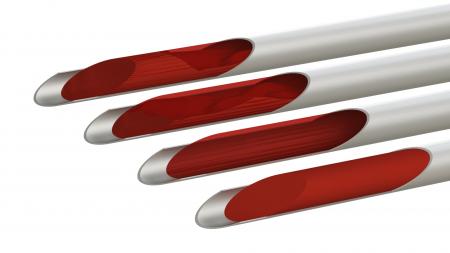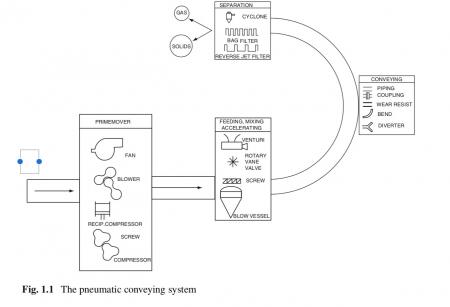This article discusses:
- Advantages and disadvantages of pneumatic transport
- The four types of pneumatic transport
- Calculations for pneumatic transport systems
The experts at Dinnissen Process Technology are available to answer all your questions:
Get in touch with Juul Jenneskens 077 467 3555
Advantages and disadvantages of pneumatic transport
Pneumatic transport has been used since the end of the 19th century. Initially for the transport of grain, and over the years it has spread more and more in the industry thanks to the various innovations in the field of pneumatic transport. Pneumatic transport is currently used in food, dairy, pet food, feed and chemicals. A wide variety of dry powders, granules and granulates are transported with pneumatic transport. Examples of products that are pneumatically transported are: cocoa, coffee, flour, milk powder, salt, sugar, silica, corn starch, animal feeds, premixes and soap. However, this is only a brief summary of products that are pneumatically transported in daily practice. Usually air is used for the pneumatic conveying of products. Depending on product characteristics, this air can be conditioned. The air is cooled and / or dried. This happens when products smear when they get too hot or are hygroscopic. In addition, there may be specific circumstances, such as ATEX risks or specific product properties, that require a different type of gas. In this case, nitrogen is used to pneumatically transport the product. In general, pneumatic transport is not applicable to break-sensitive products, very large product particles and to greasy, sticky and hygroscopic products. This is because there is a risk that the pipes will clog up. This problem is exacerbated in blow transport because the air is heated by compression.
Some advantages of pneumatic transport are:
- Low maintenance and low labor costs,
- Dust-free transport of a wide variety of products,
- Both horizontal and vertical transport possible,
- Great freedom in the routing of transport lines,
- Suitable for transporting substances with an ATEX risk or risk of oxidation.
However, there are also disadvantages of pneumatic transport such as:
- Energy consumption,
- Wear of pipework and other installation parts as a result of the abrasiveness of products,
- Chance of product breakage,
- Contamination between different batches,
- Limited distances depending on the applied concept.

Pneumatic transport
The four types of pneumatic transport
Pneumatic transport can be divided into four different types:
- dense phase,
- pulse phase,
- dune flow,
- dilute phase.
The properties of the product to be transported must be leading in the choice of the transport type, flow rate, absolute pressure and pipe diameters in the system. Ultimately, all this together determines the maximum length over which the product can be transported. In addition, process properties are relevant in the choice that is made. Breakage caused by the system, product heating causing smearing or ATEX risks in the process are all examples of things that must be assessed and taken into account in the final design.
Another way of classifying pneumatic transport is the way in which the product is transported. This can be done by means of overpressure, underpressure or a closed loop system. The advantage of an overpressure system is that it can bridge greater distances. The disadvantage is that there is a greater chance of product leakage. The advantage of a negative pressure system is that it is easier to create multiple entry points and that there is less chance of product leakage. A disadvantage is that less long distances can be bridged.
The choice of suction or blow transport is usually determined by:
Suction transport:
- Multiple recording points are possible. For example with several locks in a row,
- Leakage air from locks is less critical, but must be included in the calculation,
- The distance is limited due to maximum pressure difference of approx. 500 mbar,
- A larger pipe diameter is required due to lower airtightness,
- The permitted bulk density of the product to be transported is limited.
Blow conveyance:
- Entry point is an airtight intake point,
- Airtight construction of the system is very important,
- Leakage air at locks is very critical in a blow transport,
- The blower should be chosen larger when using locks because of the leakage air,
- Long distances are possible,
- Higher bulk weights are possible.
The foundation of a pneumatic system always consists of four main components:
- The driving force. This can be a fan, blower, vacuum pump, or compressor.
- A product feeder. This is used to introduce the product into the pneumatic transport system.
- Piping. This includes pipes, bends, switches, diverters, and couplings.
- Separator. Here, the gas must be separated from the product again.

Pneumatisch transport system
Pneumatic conveying has been used since the end of the 19th century
In de onderstaande tabel zijn de verschillende vormen van pneumatisch transport naast elkaar uitgezet
| Type of conveying | Type of air displacement | System pressure | Maximum distance | Advantages | Disadvantages |
| Dilute phase | positive pressure (blowing) | max. 800 mBar | 150 meter |
|
|
| Dilute phase | negative pressure (vacuum) | Min. -500 mBar | 100 meter |
|
|
| Dense Phase | positive pressure (blowing) | 1 Bar - 5 Bar | 200 meter |
|
|
| Dense Phase | negative pressure (vacuum) | Min. -900 mBar | 100 meter |
|
|
Calculation of pneumatic transport
When conveying product particles by means of gas, the gas has a certain speed. Contrary to what men would initially expect, the speed of the particles is not equal to the speed of the gas. Because the particles experience friction in the air flow, as a result of gravity and collide with the walls of pipes, they will have a lower speed than the speed of the air flow. The difference in speed is called the slip factor. To calculate the slip factor you can use this formula shown here.

Name: Juul Jenneskens
Advisor
Please feel free to contact me if you have any questions about this subject. My team of colleagues and I are ready to answer!
Get in touch with Juul Jenneskens 077 467 3555 [email protected]
Do you prefer to request a consultation directly?
